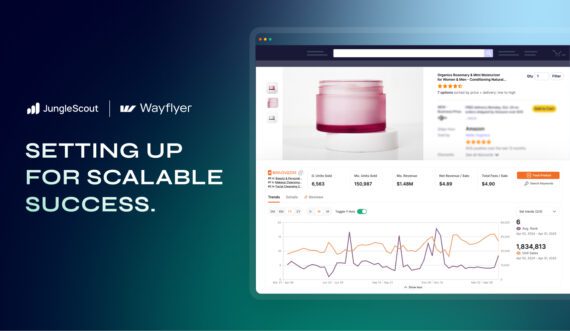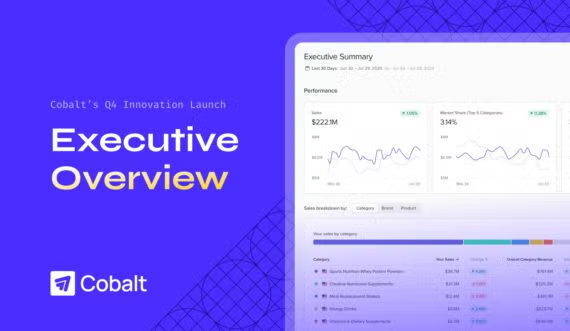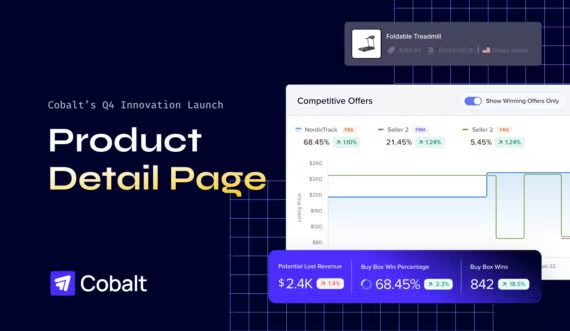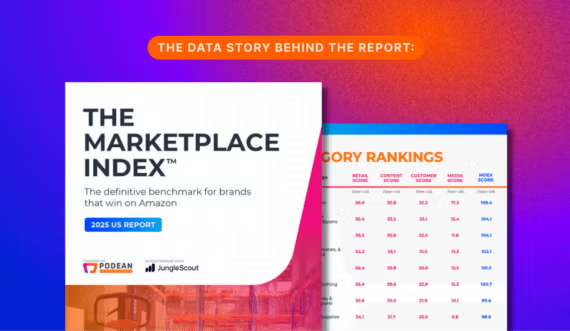Understanding the full financial health of your Amazon business is vital to your success as a seller. Between product costs, Amazon fees, and marketing expenses, it’s difficult to figure out if you’re making a profit — and easy to run your business at a loss unknowingly.
While you can track your product sales and expenses manually through spreadsheets, using a tool that automatically records and organizes your financial Amazon data removes the guesswork and frustration.
Amazon sales analytics tools help sellers track these key areas by providing data on trends, expenses, and performance. With the right tools, you can get a clear picture of your business’s health and make smarter decisions that improve your bottom line.
What are Amazon seller analytics tools?
Amazon seller analytics tools are software that gathers, organizes, and displays important sales data to help you better understand your Amazon business’s financial health. They are designed to help Amazon sellers monitor crucial business metrics.
- Sales trends: How well your Amazon products are selling over time and identify trends such as seasonality or a decline or increase in sales.
- Financial performance: Sales analytics tools track the profit and loss across your whole business and down to the product level. Have a full understanding of how your Amazon business is performing.
- Operational metrics: Analyze and track costs such as Amazon referral fees, FBA fees, storage costs, returns, inbound and outbound shipping, advertising, and more.
By using sales analytics tools, Amazon sellers can monitor their profitability, pinpoint strong and weak products, and manage their budgets. The main purpose of these tools is to help Amazon sellers make data-driven decisions to grow their ecommerce business effectively and profitably.
If you find weak products, you can begin to phase them out of your business and begin product and market research to find a better-suited product.
Why are Amazon sales analytics important?
Selling on the Amazon marketplace comes with various expenses that can quickly eat up your profit margin. If you’re not paying attention to these expenses, you may spend more money than you realize. I’m talking about things like:
- Referral fees
- FBA fees
- Shipping costs
- Storage fees
- Advertising budget
- Product costs
Amazon FBA Fees: How Much Does it Cost to Sell on Amazon in 2024?
This article takes a look at the fees you’ll pay as an Amazon seller.
Staying on top of your business’s financial health includes tracking and analyzing your monthly sales metrics and expenses to get a picture of your performance, both overall and on specific aspects of your business.
This can be done manually by entering Seller Central report data into a spreadsheet or by letting some kind of sales analysis software do the work.
Many sellers swear by the old-school data entry method. Here’s the thing: manually downloading reports and entering the data into a spreadsheet is extremely tedious and can get confusing. And if you miscalculate data or mistakenly leave something out, it’s downright counterproductive.
This is why it is important to use digital tools to record, organize, and track every dollar that comes in and out of your Amazon business.
Important metrics to monitor with Amazon seller analytics tools
Amazon analytics tools allow sellers to track many different metrics, but some are especially important for understanding and improving business performance:
Profitability. Metrics like net profit, gross margin, ROI, and cost of goods sold show if your business is financially healthy. Track your business profit and loss as a whole or down to the product level so you can make decisions about a particular product.
Revenue. Metrics like daily or monthly sales, conversion rates, and revenue growth help sellers see if sales are increasing, steady, or dropping. Based on the information you find, you can make adjustments to your business operations.
Amazon fees and various costs. Sellers should monitor Amazon fees, advertising costs, promotions, returns, and any other expenses that impact profits. Fees can easily eat up profits for Amazon sellers. Stay on top of exactly what you are paying for each month.
Monitoring these metrics can help sellers identify growth opportunities, cut unnecessary expenses, and keep their businesses on track.
What tools are best for Amazon sales analytics (and why)?
Now that you know how important it is to use an Amazon sales analytics tool to track the performance of your Amazon business, let’s go over some of the best Amazon sales analytics tools.
Jungle Scout Sales Analytics
With Sales Analytics, Jungle Scout users can easily track sales, Amazon fees, and other expenses in real-time, all in one place. Think of it as your financial command center, where you can zero in on profit-building and cost-saving strategies to help you earn more money with Amazon FBA. 
AI Profit Analysis
Jungle Scout’s new AI Assist feature analyzes your Profit Overview data, including revenue, cost of goods sold, and fees, and instantly delivers a comprehensive financial report. AI Assist will also provide you with key insights about your business along with tips to improve your sales, profitability, and how to optimize for growth.

How can Sales Analytics help you?
Sales Analytics arms you with a variety of capabilities that help you collect and make sense of your key Amazon financial metrics. Here’s an overview of what you can expect to gain by using this tool.
- Know your real-time sales. As shoppers purchase your products on Amazon, you get instant visibility into what they’re buying and how they’re buying it.
- Determine your margins. Want to know your exact net profit? The margin widget shows you your earnings and the percentage of your product’s price that goes back to you as profit.
- Uncover your ROI. Calculate your return on investment based on your profits, inventory costs, and other direct expenses.
- View product-specific sales data. Filter by product name, ASIN (Amazon Standard Identification Number), or SKU (stock-keeping unit) to see how a specific product is selling. Explore unique sales and revenue details, supplier and shipping costs, and PPC (pay-per-click) campaign performance, among other information. Compare sales and profits over time. Want to know how a certain product is selling week to week or month to month? View detailed charts to compare performance metrics over time and see how promotions, refunds, and other variables impact your bottom line.
- Break down your costs. Keep an eye on both direct and indirect expenses, including order fees, unit costs, PPC advertising, salaries, shipping and inventory costs, legal fees and taxes, and more. You can also enter custom expenses and transactions unique to your business.
- Understand your ad spend. Amazon PPC is an important part of getting your product in front of more shoppers on Amazon. Sales Analytics helps you track and manage your PPC spend to keep your profit margins healthy. This lets you see your actual day-to-day profits and expenses.
- Track your shipments. Want to know when your inventory is going to arrive at the target Amazon fulfillment center? Sales Analytics also lets you conveniently track your inbound FBA shipments.
Start tracking your FBA business' profits, fees, and financial health today.
Click below to sign up for Sales Analytics.
ManageByStats
ManageByStats is another tool for Amazon analytics. It focuses on essential metrics like profit, customer behavior data, and order trends. While it’s useful for small to medium-sized sellers, ManageByStats lacks some of Jungle Scout’s advanced features, such as AI profit analysis. This can make it less effective for larger businesses or those wanting more in-depth insights.

DataHawk
DataHawk is a data-heavy tool that focuses on analytics and reporting. It provides custom reports and data visualization, which appeals to sellers who want detailed insights. However, DataHawk’s lack of real-time insights and fewer direct action tools can make it less suitable for sellers who need immediate, actionable data.

SellerApp
SellerApp helps sellers with product listing optimization, ad tracking, and sales data. It’s designed for small sellers who want basic analytics features without overwhelming complexity. However, compared to Jungle Scout, it lacks more advanced tools for managing profitability and expenses, making it less ideal for sellers who need comprehensive sales data.

How to use Amazon sales analytics data effectively
To benefit the most from your Amazon sales analytics software, here is what you should focus on the most to ensure you’re using the data provided most effectively.
Track profitability in real time
Using Jungle Scout’s Profit Overview, sellers can see current and historical sales data and product profitability.
This feature tracks revenue, fees, ROI, COGS, and other expenses for each product, making it easy to identify where you are winning and losing. By catching any issues early, sellers can proactively make changes to avoid any loss in sales or profitability,
Sellers can also create a professional profit and loss statement to provide a full picture of their business’s financial health. This statement should include all important metrics, such as revenue, Amazon fees, costs of goods sold, and operating expenses.

Optimize inventory based on sales data
Jungle Scout’s Product Tracker and Inventory Manager help sellers monitor demand and plan inventory. By knowing which products are selling well and which are slower, sellers can avoid overstock and stockouts.
These tools also provide sales forecasts, which guide reordering decisions and keep inventory balanced. By being able to predict FBA sales and profits, you as a seller can avoid costly Amazon storage fees if your inventory is stored in Amazon’s fulfillment centers for too long.
Monitor fees and reduce unnecessary costs
Amazon fees and costs can add up, impacting overall profitability — especially if you are not paying attention to them. Jungle Scout’s comprehensive reports within Sales Analytics with AI Assist instantly delivers a detailed financial report featuring need-to-know insights and tips for ways you can improve your sales and optimize for growth and where to cut down on unnecessary expenses.
Evaluate product performance
With Jungle Scout’s Sales Analytics, sellers can see how each SKU performs over time and view important metrics such as sales and revenue details, PPC campaign performance, and supplier and shipping costs.
This tool makes it easy to compare multiple products, adjust pricing, or explore other sales strategies to boost performance.
After seeing which of your products are performing the best, you can use the Jungle Scout Product Database to conduct product research to find more products that complement your current successful products.
Sellers can also use Jungle Scout’s Rank Tracker to keep track of their keyword rankings across all products. Sellers also use Keyword Scout to conduct proper keyword research to include specific search terms within their listings and PPC campaigns.
Why is Jungle Scout’s Sales Analytics the best tool for you?
Jungle Scout’s Sales Analytics can reveal valuable insights that are often overlooked, like storage costs or trends in returns, and streamline the financial data for your business. Metrics like these are crucial for keeping costs down and understanding full product performance.
Jungle Scout’s tools also help sellers plan for peak seasons by showing detailed sales trends, making it easier to prepare for high-demand times.
With Jungle Scout, sellers gain access to a powerful suite of tools that go beyond sales and Amazon brand analytics, providing a one-stop shop for all their Amazon business needs.
Using Amazon sales analytics tools, like Jungle Scout, is one of the best ways to make informed business decisions. Tracking key metrics—like profitability, sales trends, and costs—can help sellers stay on top of their game.
Jungle Scout offers all the insights needed to grow your Amazon business and turn data into profits. Explore Jungle Scout’s pricing options to get started today.
Learn more about Jungle Scout's suite of Amazon data intelligence tools.
Brian Connolly is an Amazon seller, ecommerce expert, and writer for Jungle Scout. He lives in the New Jersey Shore area with his wife and cat. When he isn’t writing advice online for aspiring and experienced Amazon sellers for Jungle Scout, he spends his free time boating, fishing, and selling boating-themed items on his Amazon business.










